A) should raise price and decrease output.
B) should lower price and increase output.
C) should lower price and decrease output.
D) is incurring an economic loss.
E) is maximizing profit.
Correct Answer

verified
Correct Answer
verified
Multiple Choice
Use the figure below to answer the following question.
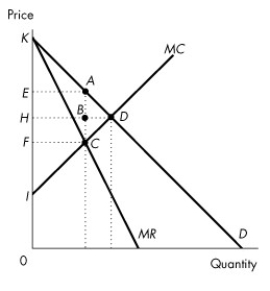 Figure 13.4.1
-When perfect price discrimination occurs,which one of the following statements is false ?
Figure 13.4.1
-When perfect price discrimination occurs,which one of the following statements is false ?
A) Buyers cannot resell the product.
B) The firm can distinguish between buyers.
C) The firm sets prices.
D) The firm captures consumer surplus.
E) The outcome is less efficient than with single-price monopoly.
Correct Answer

verified
Correct Answer
verified
Multiple Choice
A monopoly
A) faces a perfectly elastic demand.
B) ignores the demand curve because it is the only seller.
C) can raise the price it charges only if it decreases the quantity that it sells.
D) can raise the price it charges only if it increases the quantity that it sells.
E) faces a perfectly inelastic demand.
Correct Answer

verified
Correct Answer
verified
Multiple Choice
In a natural monopoly,the long-run average cost curve
A) is downward sloping in the relevant range of output levels.
B) is horizontal in the relevant range of output levels.
C) is upward sloping in the relevant range of output levels.
D) may be either upward sloping or downward sloping in the relevant range of output levels.
E) lies below the marginal cost curve.
Correct Answer

verified
Correct Answer
verified
Multiple Choice
Use the figure below to answer the following questions.
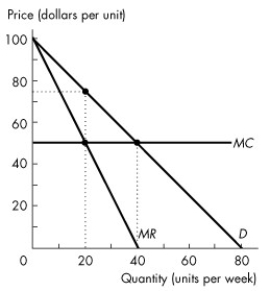 Figure 13.3.1
-Refer to Figure 13.3.1.If this market were perfectly competitive,the output level would exceed the single-price monopoly output level by
Figure 13.3.1
-Refer to Figure 13.3.1.If this market were perfectly competitive,the output level would exceed the single-price monopoly output level by
A) 20 units.
B) 40 units.
C) 60 units.
D) zero.The perfectly competitive firm and the single-price monopoly produce the same quantity because marginal cost is constant.
E) 30 units.
Correct Answer

verified
Correct Answer
verified
Multiple Choice
Use the figure below to answer the following questions.
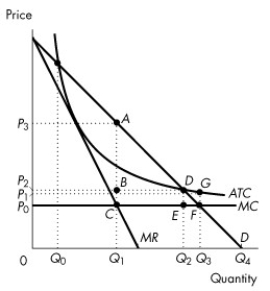 Figure 13.5.2
-Consider the natural monopoly depicted in Figure 13.5.2.If a regulator uses a marginal cost pricing rule to set price,what is the quantity produced?
Figure 13.5.2
-Consider the natural monopoly depicted in Figure 13.5.2.If a regulator uses a marginal cost pricing rule to set price,what is the quantity produced?
A) 0
B) Q0
C) Q1
D) Q2
E) Q3
Correct Answer

verified
Correct Answer
verified
Multiple Choice
Use the figure below to answer the following questions.
 Figure 13.5.2
-Consider the natural monopoly depicted in Figure 13.5.2.What area in the graph represents the deadweight loss arising from an average cost pricing rule?
Figure 13.5.2
-Consider the natural monopoly depicted in Figure 13.5.2.What area in the graph represents the deadweight loss arising from an average cost pricing rule?
A) ABD
B) DGF
C) DEF
D) ACF
E) CBDE
Correct Answer

verified
Correct Answer
verified
Multiple Choice
For a monopoly able to practice perfect price discrimination,the market
A) supply curve is horizontal.
B) supply curve is the same as the marginal revenue curve.
C) demand curve is the same as the marginal cost curve.
D) demand curve is the same as the marginal revenue curve.
E) demand curve is horizontal.
Correct Answer

verified
Correct Answer
verified
Multiple Choice
A monopoly arises for two key reasons,which are ________.
A) barriers to entry and no close substitutes
B) franchises and barriers to entry
C) barriers to entry and close substitutes
D) close substitutes and no barriers to entry
E) natural and legal
Correct Answer

verified
Correct Answer
verified
Multiple Choice
A perfect price-discriminating monopoly
A) has a demand curve that is also its marginal revenue curve.
B) maximizes total revenue.
C) is inefficient.
D) will produce the quantity at which the marginal cost curve intersects its demand curve.
E) both A & D are correct.
Correct Answer

verified
Correct Answer
verified
Multiple Choice
Use the figure below to answer the following questions.
 Figure 13.5.2
-Consider the natural monopoly depicted in Figure 13.5.2.If a regulatory agency sets a price just sufficient for the firm to make zero economic profit,what output will it produce?
Figure 13.5.2
-Consider the natural monopoly depicted in Figure 13.5.2.If a regulatory agency sets a price just sufficient for the firm to make zero economic profit,what output will it produce?
A) Q4
B) Q0
C) Q1
D) Q2
E) Q3
Correct Answer

verified
Correct Answer
verified
Multiple Choice
For a single-price monopoly,the demand curve is
A) below the marginal revenue curve.
B) the same as the marginal revenue curve.
C) above the marginal revenue curve.
D) the same as the total revenue curve.
E) below the average total cost curve.
Correct Answer

verified
Correct Answer
verified
Multiple Choice
Consumer surplus is
A) positive in the case of a monopolist practising perfect price discrimination.
B) equal to price minus marginal cost.
C) less in the case of a single-price monopoly than in the case of a perfectly competitive industry.
D) zero for a single-price monopolist.
E) greater in a single-price monopoly than in a perfectly competitive industry.
Correct Answer

verified
Correct Answer
verified
Multiple Choice
Use the table below to answer the following questions.
Table 13.4.1
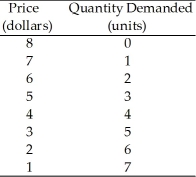 -Table 13.4.1 shows the demand schedule faced by a perfect price-discriminating monopoly.If 3 units are sold,total revenue is
-Table 13.4.1 shows the demand schedule faced by a perfect price-discriminating monopoly.If 3 units are sold,total revenue is
A) $15.00.
B) $16.00.
C) $18.00.
D) $19.50.
E) $5.00.
Correct Answer

verified
Correct Answer
verified
Multiple Choice
A natural monopoly exists when
A) the government protects the firm by granting an exclusive franchise.
B) production can take place with constant returns to scale.
C) there are no rivals in the market.
D) one firm can supply the entire market at a lower cost than two or more firms.
E) the average total cost curve is upward sloping.
Correct Answer

verified
Correct Answer
verified
Multiple Choice
A monopoly is a market with a single firm that
A) produces a good or service for which no close substitute exists and which is protected by a barrier that prevents other firms from selling that good or service.
B) purchases its factors of production from only one supplier because of a barrier preventing it from buying from other suppliers.
C) produces a good or service for which no close substitute exists and that sells all its output to one buyer because there is barrier preventing other buyers from purchasing the good or service.
D) cannot control the price it sets for its good or service because there is barrier that prevents the firm from changing the price.
E) produces its good or service using labour from a single source, which is usually a union.
Correct Answer

verified
Correct Answer
verified
Multiple Choice
Use the figure below to answer the following questions.
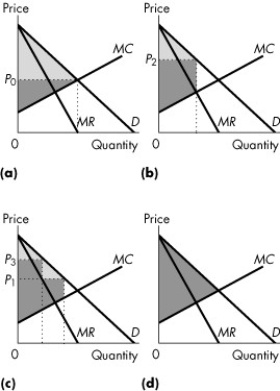 Figure 13.3.2
-Consider Figure 13.3.2.Consider a perfectly competitive market.If the light grey area shows the consumer surplus,and the dark grey area shows the producer surplus,which graph correctly represents this market?
Figure 13.3.2
-Consider Figure 13.3.2.Consider a perfectly competitive market.If the light grey area shows the consumer surplus,and the dark grey area shows the producer surplus,which graph correctly represents this market?
A) (a)
B) (b)
C) (c)
D) (d)
E) (b) and (d)
Correct Answer

verified
Correct Answer
verified
Multiple Choice
Use the figure below to answer the following questions.
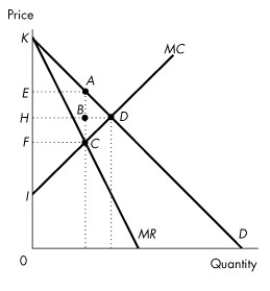 Figure 13.3.3
-Refer to Figure 13.3.3.What is the redistribution of surplus from consumers to the producer with a single-price monopoly,as compared to a perfectly competitive market?
Figure 13.3.3
-Refer to Figure 13.3.3.What is the redistribution of surplus from consumers to the producer with a single-price monopoly,as compared to a perfectly competitive market?
A) EADH
B) EABH
C) ABD
D) ACD
E) EABH - BCD
Correct Answer

verified
Correct Answer
verified
Multiple Choice
Use the figure below to answer the following questions.
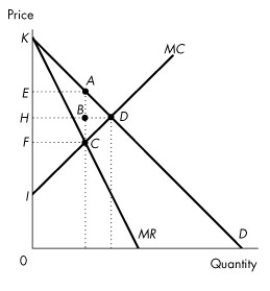 Figure 13.4.5
-Consider the cost and revenue curves in Figure 13.4.5.If this is a perfect price-discriminating monopoly,what is consumer surplus?
Figure 13.4.5
-Consider the cost and revenue curves in Figure 13.4.5.If this is a perfect price-discriminating monopoly,what is consumer surplus?
A) EADH
B) EABH
C) ABD
D) KEA
E) None of the above.
Correct Answer

verified
Correct Answer
verified
Multiple Choice
Use the figure below to answer the following questions.
 Figure 13.3.1
-Refer to Figure 13.3.1.If this market is a single-price monopoly,then
Figure 13.3.1
-Refer to Figure 13.3.1.If this market is a single-price monopoly,then
A) it is efficient because the monopoly is maximizing economic profit.
B) price is equal to marginal cost and the outcome is efficient.
C) price is less than marginal cost, and consumer surplus is less than in a perfectly competitive market.
D) price is greater than the marginal cost and the outcome is inefficient.
E) the outcome is inefficient because the monopoly's costs are too high.
Correct Answer

verified
Correct Answer
verified
Showing 41 - 60 of 107
Related Exams